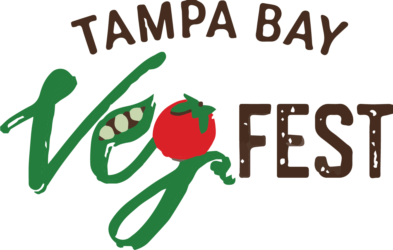
WHY IS TAMPA BAY VEG FEST A VEGAN EVENT?
Thank you to Vegetarians of Central Florida and Central Florida Veg Fest for your detailed explanation of a vegan lifestyle.
For Our Health:
Numerous studies have documented a plant-based diet as being healthier than diets containing animal products. Besides avoiding cholesterol, saturated fat and carcinogens found only in dairy products such as casein, plant-based diets omit the by-products of industrialized animal agriculture, such as growth hormones and antibiotics (According to Dr. Michael Greger, “Endogenous steroid hormones in food of animal origin are unavoidable as they occur naturally in these products. It’s not a matter of injected hormones, which are banned in places like Europe in order to protect consumers’ health.”
Conversely, vegan diets are higher in fiber, antioxidants, and vitamins and minerals.
Current research indicates that cardiovascular diseases, many cancers, diabetes, and many other ailments are often prevented or reversed by vegan lifestyles. For example, a recent study funded by the National Cancer Institute reported that vegans have lower rates of cancer than both meat-eaters and vegetarians.
The American Dietetic Association has taken the position that ”appropriately planned vegetarian diets, including total vegetarian or vegan diets, are healthful, nutritionally adequate, and may provide health benefits in the prevention and treatment of certain diseases. Well-planned vegetarian diets are appropriate for individuals during all stages of the life cycle, including pregnancy, lactation, infancy, childhood, and adolescence, and for athletes.” The ADA has also said that ”Not only is mortality from coronary heart disease lower in vegetarians than in non-vegetarians, but vegetarian diets have also been successful in arresting coronary heart disease. Scientific data suggest positive relationships between a vegetarian diet and reduced risk for…obesity, coronary artery disease, hypertension, diabetes mellitus, and some types of cancer.”
Additional resources:
http://nutritionfacts.org/
http://www.pcrm.org/health
http://www.whatthehealthfilm.com
http://www.plantpurenation.com
http://www.forksoverknives.com
http://www.thechinastudy.com/
http://www.plantbasedonabudget.com
https://www.balancemebeautiful.com
For the Animals:
Over 9 billion land animals and billions more sea animals are slaughtered each year to become food, clothing, and other consumer products. Each of the chickens, cows, pigs, turkeys, ducks, fish, and others who are killed for human use are sentient beings with complex central nervous systems, which allow them to feel pain and to suffer.
In addition to the act of slaughter, which inherently causes a great deal of unnecessary pain, fear, and suffering, the methods by which animals are bred, raised, confined, and transported are, by any reasonable definition, inhumane, despite humane labels such as “cage-free,” “free range,” “humanely raised,” “grass fed,” etc. Young animals are often ripped away from their mothers moments after birth, unhealthy animals are often pushed by bulldozers into trash heaps, and animals are often unintentionally killed during long, cramped transports.
The meat, dairy, egg, veal, wool, and leather industries are all closely connected and interdependent. Consuming dairy and eggs contributes directly to meat industries. From male chicks being disposed of alive by the egg industry, to the leather industry being directly funded by meat, to the male calves of dairy cows being used for veal, it is impossible to consume non-meat animal products without benefiting the meat industries and causing animal suffering.
As science and ethical systems have evolved, so too has our understanding of animal suffering. The 19th century philosopher Jeremy Bentham observed, ”The question is not, Can they reason? Nor, Can they talk? but, Can they suffer?”
The Cambridge Declaration on Consciousness in Non-Human Animals, which was publicly proclaimed in Cambridge, UK, on July 7, 2012, concluded that ”humans are not unique in possessing the neurological substrates that generate consciousness.”
Additional resources:
http://www.humanesociety.org/animals/
http://www.farmsanctuary.org/learn/someone-not-something/ http://www.mercyforanimals.org/investigations
http://www.veganoutreach.org/whyvegan/
http://www.nationearth.com/
For Human and Labor Rights :
The excessive resource use of animal agriculture deprives land, fuel, grain, water and other resources to vulnerable populations of people, leading to hunger, drought, regional resource conflicts, and displacement.
Marc Bekoff has written, “A reduction of meat consumption by only 10% would result in about 12 million more tons of grain for human consumption. This additional grain could feed all of the humans across the world who starve to death each year- about 60 million people.”
Jeremy Rifkin, president of the Foundation on Economic Trends in Washington, DC, stated: “People go hungry because much of arable land is used to grow feed grain for animals rather than people.” Rifkin offered as one example the Ethiopian famine of 1984, which was fueled by the meat industry. “While people starved, Ethiopia was growing linseed cake, cottonseed cake and rapeseed meal for European livestock. Millions of acres of land in the developing world are used for this purpose. Tragically, 80 percent of the world’s hungry children live in countries with food surpluses which are fed to animals for consumption by the affluent.”
Additionally, factory farms, slaughterhouses, and other places where animals are processed are commonly cited as some of the most dangerous and unfair workplaces. OSHA reports that over 9,003 farm workers died from work-related injuries in the US between 1992 and 2009. Workers in the meat industry make an average of $23,000 a year, work 10+ hours a day, and suffer a repetitive motion injury rate 30 times the national average.
Factory farm workers routinely inhale hazardous levels of particulate matter as well as ammonia and hydrogen sulfide gases. A 2002 Iowa State study found that as many as 70% of U.S. factory farm workers suffer from acute bronchitis, and 25% battle chronic bronchitis.
Additional resources:
http://www.sustainabletable.org/273/workers
http://www.foodispower.org/factory-farm-workers/
http://www.motherjones.com/environment/2014/10/hog-hell-inside-story-peta-investigati on-mowmar-farms?page=2
http://www.onegreenplanet.org/animalsandnature/the-human-cost-of-industrial-animal-a griculture/ http://www.huffingtonpost.com/lucas-spangher/plight-of-factory-farm-workers_b_566226 1.html
For the Environment:
Animal agriculture is the leading cause of environmental devastation. From the widespread contamination of drinking water supplies in North Carolina by hog manure runoff to the exponential deforestation of the Amazon rainforest due to cattle ranching in Brazil to the rise of drug-resistant pathogens as the result of feeding antibiotics to chickens on American factory farms raising animals for their meat, milk, eggs and skin creates problematic consequences for public health, natural resource management, biodiversity conservation, and wilderness preservation.
When people eat and wear animals, we use more land, fuel, water, fertilizer, antibiotics, pesticides, and grain, than we do when we engage in any other agricultural practice. The production of one quarter-pound hamburger requires 6.7 pounds of grain and forage, 52.8 gallons of water, 74.5 square feet of land, and 1,036 BTUs of fossil fuel. Producing meat, dairy, eggs, leather, wool, and so forth cycles finite resources through animals to achieve a net loss of resources.
The UN Commission on Sustainable Development reported that it takes up to 7,000 liters of water to produce 100 grams of beef in developing countries, while it takes just 550 liters of water to produce enough flour for one loaf of bread (9). Further, a global assessment of the water footprint of farm animal products was published in the academic journal Ecosystems in 2012 and it concluded that the water footprint of any animal product is larger than the water footprint of crop products with equivalent nutritional value. Twenty-nine percent of the total water footprint of the agricultural sector in the world is related to the production of animal products, with the average water footprint per calorie for beef found to be 20 times larger than for cereals and starchy roots, and the water footprint per gram of protein for milk, eggs and chicken meat found to be 1.5 times larger than for legumes, for example.
Similarly, limited energy resources are negatively impacted by the use of animals for food and fiber. In a study published by the American Journal of Clinical Nutrition, the average fossil energy input for all animal protein production was found to be more than 11 times greater than that for grain protein production.
In terms of land use, livestock now use 30 percent of the earth’s entire land surface, including 33 percent of the global arable land used to produce feed for livestock. Further, animal consumption is a major driver of deforestation, with some 70 percent of former forests in the Amazon having been turned over to grazing.
With regards to global climate change, one of the most pressing environmental issues of our time, a 2013 report of the Food and Agriculture Organization of the United Nations found that greenhouse gas emissions from animal agriculture represent 14.5 percent of human-induced emissions. Feed production and processing, enteric fermentation, manure storage and processing, and transportation and processing of animals products account for these massively unique emission levels.
In addition to unsustainable resource consumption and contribution to global climate change, animal agriculture serves as a major source of air, water, and soil pollution. According to the EPA, ”A single dairy cow produces about 120 pounds of wet manure per day, which is equivalent to the waste produced by 20-40 people”. Additionally, the EPA reports that the waste generated by animal agriculture has polluted over 35,000 miles of river in 22 states.
Ground soil is also degraded by nutrients and heavy metals present in animal feed which are inevitably excreted by livestock. When concentrated due to animal agriculture’s unsustainable practices, zinc, copper, chromium, arsenic, cadmium and even lead, build up in the soil and reduce fertility, runoff into water, and end up in the human food supply.
Into our air, factory farms emit harmful gases and particles such as methane and hydrogen sulfide, which can contribute to air quality degradation and harm the health of those living or working nearby.
The size and level of industrialization of animal agriculture operations certainly contribute to the unsustainable resource consumption, pollution, and pathogenic impact of meat, dairy, leather, eggs, wool, and other animal products. However, regardless of scale and degree of mechanization, animal operations are inevitably relatively unsustainable. Even free-range, cage-free, pasture/grass-raised, organic, and local meat, eggs and dairy still require more land, water, fossil fuels, chemicals, and feed inputs and are more polluting than sustainable methods of agriculture such as organic vegetable and fruit production, permaculture, agroforestry, urban gardening, and hydroponics. A wide-array of factors go into determining the overall environmental sustainability of a product or process, and environmentally unsound practices are of course found in all types of agricultural production, not just that of animal products. But it is clear that acre for acre, pound for pound, and gallon for gallon, animal agriculture, regardless of its level of industrialization, location, or size, is relatively environmentally harmful and unsustainable relative to other types of comparable agriculture.
Environmentalists around the world and from diverse disciplines and backgrounds have expressed concern over the environmental impacts of using animals for food and fiber and made addressing such concern key component of their work. Robert F. Kennedy, Jr., president of Waterkeeper Alliance and environmental lawyer, has said, “Corporations that now control the meat production industry are threatening public health”.
Additional resources:
http://www.nrdc.org/food/saving-antibiotics.asp
http://www.worldwatch.org/node/549
http://www.fao.org/ag/magazine/0612sp1.htm
http://www.gatesnotes.com/Books/Harvesting-The-Biosphere
http://www.waterfootprint.org/Reports/Mekonnen-Hoekstra-2012-WaterFootprintFarmAn imalProducts.pdf
http://ajcn.nutrition.org/content/78/3/660S.full
http://www.npr.org/blogs/thesalt/2012/06/27/155527365/visualizing-a-nation-of-meat-eat ers
http://www.sustainabletable.org/265/environment
http://www.theguardian.com/environment/2010/jun/02/un-report-meat-free-diet
http://www.cowspiracy.com

